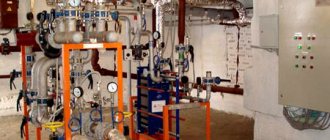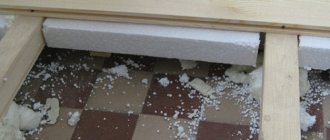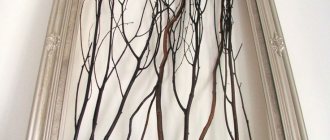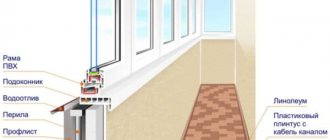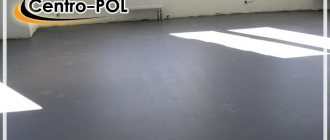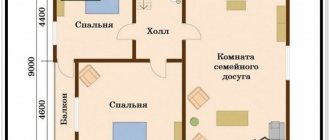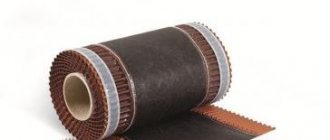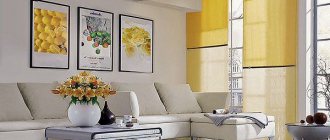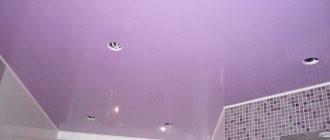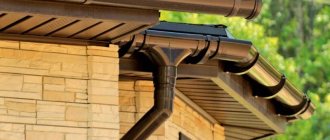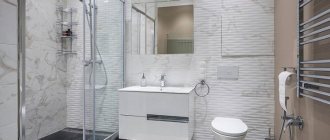To ensure that the premises are comfortable and the air exchange occurs in accordance with the standards, each residential building is equipped with a ventilation system. This also applies to multi-storey buildings, which represent the main segment of urban housing.
During construction, standard schemes of ventilation systems in an apartment building are used, thanks to which various air circulation modes are implemented.
In this article we will analyze the features of traditional schemes, the subtleties of arranging forced ventilation and the nuances of arranging ventilation for a sewer system.
What the regulations say
The common shaft of the ventilation duct of a panel high-rise building.
According to SNiPs, air exchange indicators for rooms in an apartment are established:
- Kitchen space 90 m3/hour;
- Toilet – 50 m3/hour;
- Bathroom and bathroom combined with it – 25 m3/hour;
- Living rooms - 3m3/hour per 1 m2.
Definition
Khrushchevkas are apartment buildings built according to a standard design from the early 50s to the early 80s. The name was given by the surname of the general secretary of the party, Nikita Sergeevich Khrushchev. There are three options for constructive solutions: brick, panel and large-block houses no higher than 5 floors. The limited number of floors is due to the lack of an elevator. The architectural style of execution was called “functionalism”.
Most houses were built from large-sized panels, this is due to the speed and cost of installation. The most common 447 series, most of the cities of the Soviet Union were built with it. It features a unique window between the bathroom and the kitchen.
Almost all mass-produced houses were equipped with a gas water heater, which affected the design of the ventilation system.
Features of ventilation devices in panel apartment buildings
Depending on how the ventilation in the panel house is tripled, the air exchange in the room also occurs. Each bathroom and toilet has a separate shaft, the so-called accelerating shaft. This element of apartment ventilation is adjacent to a common shaft, through which dirty air is removed from the room. The kitchen ventilation duct is the main one. Ventilation can have either round shafts with a diameter of 150 mm or rectangular shafts.
Square ventilation ducts are very common
Important! When installing doors to the bathroom and toilet, you should not make them very airtight. The presence of “alkali” will ensure the supply of fresh air.
We ensure air circulation throughout the apartment
Having cleaned and studied the exhaust ventilation system in the Khrushchev building, it’s time to tackle the problem of air movement inside the apartment itself.
In order for air to flow freely between rooms, it is necessary to remove the thresholds of interior doors. A gap 3 cm wide is sufficient. Some owners prefer to drill holes with a diameter of 0.8 - 1.5 cm in three rows at the bottom of the door. You can cover them with a decorative lattice.
Holes in the bathroom, bathroom and bedrooms can be made sloping inward so that it is impossible to peep from the outside.
A fine steel mesh in several rows perfectly muffles sounds, so the presence of holes will be invisible.
What is the best ventilation system in a panel house apartment?
The choice of ventilation system is made taking into account specific building factors:
- the number of floors in the house and on which of them the apartment is located;
- presence of traffic and third-party noise;
- air pollution.
Advice! For houses located in residential areas where the noise level is less than 50 dB, natural ventilation can be installed. But in order to create comfortable conditions in buildings where external noise exceeds 50 dB, a forced ventilation system in the apartment is recommended.
Summary
As you can see, the ventilation system is an integral component of any home. Not only the quality of indoor air depends on it, but also how the heating system will function. Thanks to the right approach to ventilation, you can significantly reduce the cost of coolants, which ensures both local and global savings.
Recommended Posts
Water heating at home
Gas boiler room for a private house
Wood-burning potbelly stoves for the garden
DIY chimney draft amplifier
Cast iron stoves for baths
Electric boiler for heating a house
You need to choose from 3 possible designs
Natural
Polluted air is removed from the room by a natural method: the draft created by the temperature difference inside the apartment and outside pushes out air masses and removes them through the ventilation ducts. Fresh air enters through open vents, and there are leaks in walls, windows and doorways.
Mechanical
The air duct can be metal or polymer.
When installing such a system, air is pumped in and removed using installed equipment - fans.
Combined
Provides a combination of ventilation and air exchange systems. That is, fans mix clean air into already recirculated air. To ensure this process, an air duct is installed outside the fan and a filter is mounted. The “exhaust” air is removed through ventilation shafts naturally.
Advice! For the installation of combined ventilation, duct-type fans such as Soler&Palau TD Silent 350/125 are an excellent installation option.
Step-by-step instructions for self-construction of a ventilation shaft
The process of constructing ventilation shafts will consist of several stages in which the following important nuances must be observed:
First of all, the template must be correctly attached to the wall. The template must fit tightly with its end part to the inner surface of the transverse wall. Then trace the template with a pencil or chalk. The circled areas are future transition areas. Use a template during installation to check for any misalignment during operation. The smallest mistakes will have a negative impact on the overall performance of your home's ventilation system.
- The shape of the air duct can be square or rectangular (for example, when choosing a non-standard cross-section, which is important if there is a strong heat source in the room).
- To ensure the quality of laying the channels, this should be done with a trowel, and excess mortar should be immediately removed with a spatula.
- To increase the strength of the constructed shaft, bricks are laid along the opening. However, this measure may make it very difficult to clean the ventilation shaft in the future.
Ventilation shafts should be located no more than one meter apart and at an angle of sixty degrees to the base of the building. Sockets are also made of brick, which is pre-laid at the required angle.
The wall is tied with halves and quarters of bricks. To ensure that the shape of the shaft remains even along its entire length, it is necessary to use special buoys for work. These same buoys will prevent debris from clogging the canal.
After completion of the brickwork, all seams in the channel must be properly sealed, and the finished trunk is checked for permeability using a special ball tied to a strong and thick cord.
When you have to change a natural system to a forced one
Ventilation in an apartment in a panel house when moving in is natural: fresh air enters the room through the window and doorways, and is discharged to the street using the main shaft. The exception is ventilation of upper floors. And it happens that it does not cope with air purification. Then additional fans are installed. Ventilation in a 9-storey panel house on the top floor occurs using individual shafts, without connecting to the main duct.
Modern buildings “don’t breathe,” which means the ventilation scheme in a particular apartment needs to be reconsidered
Important! When arranging an apartment, people focus on excessive sealing in favor of modern energy efficiency trends. In such cases, natural ventilation is no longer able to cope with its functions. This means the ventilation must be converted to forced ventilation.
The order of operation of ventilation using the example of a typical project
The most common panel project is a nine-story building. The principle of operation of the hood is the same. Air from the street, through windows and cracks, enters the apartment. The exhaust occurs through satellite ventilation ducts in the kitchen or bathroom. One, or less often several, channels from the hood are connected to the main pipe. These channels are connected to the main shaft through two floors. These shafts are quite bulky and take up a lot of space. A large-panel house will most likely be equipped with such a system.
Such a scheme for a house of 9 floors assumes the presence of a warm attic. The outlet from the 8th and 9th floors goes directly into the atmosphere, bypassing the common channel. The scheme for a 9-storey building was designed based on the complete absence of wind and an outside air temperature of +5.
Despite the fact that natural ventilation in such houses is not very effective, it requires almost no maintenance, and blockages rarely occur. There have been cases where ventilation ducts became clogged with building materials during the construction of a house. Such a surprise subsequently affected the quality of the hood. Most often, cleaning the mine is required once every 5-6 years.
During repairs, many people block the air flow in some place. They unknowingly think that this will not affect the hood, but the process of air renewal in the apartment becomes difficult or stops completely.
The most common actions leading to interference and disruption of natural ventilation:
- installation of sealed plastic windows;
- interior doors with seal;
- installation of various fans in the hood.
In order not to disrupt the operation of the natural ventilation draft, it is forbidden to obstruct the inflow and outflow of air. For plastic windows, it is necessary to install inlet openings or arrange an external inlet separately. Doors between rooms are equipped with bars at the bottom. The cross-section of the exhaust duct should not be blocked by fans.
A kitchen hood is the easiest way to improve air exchange
When installing additional ventilation in the kitchen, that is, hoods, you must be guided by SNiP 41-01-2003. You can install different types of hoods:
- Hanging ones, which are mounted directly above the gas stove. Such models “catch” exhaust air and discharge it into an individual shaft.
- Built-in, which are mounted in a special wall cabinet. Some models of this type of hoods have retractable panels, which increase the grip area.
- Dome. This type of hood is installed directly above the stove and has a more modern look.
The hood cannot be connected to a common ventilation duct.
Any hood is equipped with a filter. To maintain freshness in the kitchen, it is necessary to promptly replace multi-layer grease filters. The hood is mounted using brackets or screws, and can also be decorated with a wall cabinet if desired. The wall cabinet also houses a socket for powering electrical equipment.
Service
During operation, any ventilation system inevitably becomes clogged.
Dust from the street, grease particles from the kitchen, construction debris, etc. can get into it. The ventilation grill in the apartment may also become clogged. It is easy to check the draft level in the ventilation duct shaft. It is enough to bring the flame of a lit match or lighter closer to the grate.
When everything is in order with the draft, the fire will begin to tremble and noticeably rush towards the mine. If this does not happen, you need to remove the grill and repeat the test again.
If the flame remains motionless again, the shaft needs to be cleaned.
It is important! Fire should be handled with care - an open flame can melt the plastic grate and even ignite dust accumulations in a heavily clogged shaft. An alternative way to determine if there is a blockage is to place a thin sheet of paper or napkin on the vent. Properly functioning ventilation should hold the sheet in place without any problems
Properly functioning ventilation should hold the sheet in place without any problems.
Sometimes the flame is completely deviated in the other direction, signaling the presence of reverse draft - an unpleasant phenomenon that allows air that is not the most healthy for health and not the most pleasant odors from the ventilation shaft to penetrate into the apartment. This can be avoided by installing grilles with a check valve that allow air flow in only one direction.
Complete and effective cleaning of ventilation shafts in multi-storey buildings is carried out only by professional organizations that have special equipment: pneumatic brushes with weights, special weights, video equipment, and other devices. It is recommended to carry out such a procedure at least once every 3-5 years. In addition to mechanical cleaning, disinfection is carried out.
It is almost impossible to clean the ventilation shaft on your own. All that can be done from the apartment is to clean the channel up and down at arm's length.
Installation of air ducts in the kitchen
It will not be possible to install a hood without additional air ducts. Pipes are required for their installation. As a rule, corrugated air ducts or plastic channels are used. If you connect the hood to the main ventilation system, the quality of air exchange decreases significantly.
Important parameters of ventilation ducts
- The diameter of the air duct should be equal to the diameter of the exhaust duct or be slightly larger. A smaller pipe diameter will lead to additional load on the motor and the formation of extraneous noise.
- The number of pipe bends should be kept to a minimum. It is not allowed to install an air duct with sections where the angle of inclination is 90 degrees.
- The length of the ventilation duct must be less than 3 m.
Important! The hood in the kitchen is an additional ventilation and does not occupy the main channel. It is used as an element of complex ventilation.
When performing installation work to install a hood above the hob, it is worth considering the distance between these two objects, depending on the type of stove.
Hygienic requirements for natural and artificial lighting and insolation
5.1. Living rooms and kitchens of residential buildings must have natural lighting through light openings in the external building envelope. 5.2. The natural illumination coefficient (hereinafter referred to as KEO) in living rooms and kitchens must be at least 0.5%. 5.3. With one-sided side lighting in residential buildings, the standard value of KEO must be ensured at the design point located at the intersection of the vertical plane of the characteristic section of the room and the floor plane at a distance of 1 m from the wall farthest from the light openings: in one room - for one-, two- and three-room apartments apartments, and in two rooms for four- and five-room apartments. In the remaining rooms of multi-room apartments and in the kitchen, the standard value of KEO for side lighting should be ensured at the design point located in the center of the room on the floor plane. 5.4. All premises of residential buildings must be provided with general and local artificial lighting. 5.5. Illumination on landings, staircases, elevator lobbies, floor corridors, lobbies, basements and attics should be at least 20 lux on the floor. 5.6. Above each main entrance to a residential building, lamps must be installed that provide illumination at the entrance site of at least 6 lux for a horizontal surface and at least 10 lux for a vertical surface at a height of 2.0 m from the floor. Lighting of the pedestrian path at the entrance to the building should also be provided. 5.7. Residential premises and adjacent areas must be provided with insolation in accordance with the hygienic requirements for insolation and sun protection of premises of residential and public buildings. 5.8. The normalized duration of continuous insolation for premises of residential buildings is established for certain calendar periods differentiated depending on the type of apartments, the functional purpose of the premises, planning zones of the city and the geographical latitude of the area: - for the northern zone (north of 58° N) - at least 2, 5 hours a day from April 22 to August 22; - for the central zone (58° N latitude - 48° N latitude) - at least 2.0 hours per day from March 22 to September 22; - for the southern zone (south of 48° N) - at least 1.5 hours per day from February 22 to October 22. 5.9. The standard duration of insolation must be provided in no less than one room of 1-3-room apartments and no less than two rooms of 4 or more room apartments.
5.10. Intermittent duration of insolation is allowed, in which one of the periods must be at least 1 hour. In this case, the total duration of normalized insolation should increase by 0.5 hours, respectively, for each zone. 5.12. For residential buildings located in the northern and central zones, it is allowed to reduce the duration of insolation by 0.5 hours in the following cases: - in two-room and three-room apartments, where at least two rooms are insolated; - in four and multi-room apartments, where at least three rooms are insulated; — during the reconstruction of residential buildings located in the central and historical zones of cities, defined by their master development plans. 5.13. On children's playgrounds and sports grounds located in the local area, the duration of insolation should be at least 3 hours on 50% of the sites, regardless of geographic latitude.
Installing a fan in the bathroom and toilet
The ventilation device in a panel house also includes the installation of an additional fan in the bathroom and toilet. In this case, it is necessary to ensure its flow through the door slots, and the amount of removed and incoming air must be the same.
According to sanitary standards, air exchange in the bathroom and toilet must occur at least 8 times per hour, that is, the air in the room must change completely eight times in one hour. When choosing a bathroom fan, you should consider:
- equipment power;
- presence of noise coming from the device.
- design and colors.
- availability of additional functions.
Advice! For the bathroom and toilet today you can purchase silent fans with a timer and moisture protection, such as Maico ECA 100 ipro, Soler&Palau SILENT-100 CRZ DESIGN ECOWATT. Such equipment emits no more than 35 dB of noise, which is imperceptible to the ear.
Saving
An important aspect of life for every person is saving. The consultant pointed out to us that installing a shower cabin can save a huge amount of water and, as a result, money. This suited my husband and I very much.
It is worth noting that in this case, savings are measured not only in financial terms, but also in time, because lying in a bathtub, as a rule, takes much more time than bathing in a shower stall.
With the help of some models of shower cabins, you can achieve significant savings in room space - as practice shows, many people living in small apartments take advantage of this feature in order to accommodate the maximum number of objects in a relatively small area of the bathroom. The guy noted that shower cabin designs made entirely of transparent glass visually increase the space of the room and make its interior more stylish, and cabins with sliding doors do not require much space to open them.
Grandfather decided to send donuts for his grandchildren and used a drone
Police arrested a man who decided to live in Disneyland during quarantine
Soup from nothing: dishes tested in difficult times
Rescue of drowning people is the work of the drowning people themselves
General ventilation diagram in a high-rise panel building
According to the Housing Code, the management company is responsible for maintaining communications in apartment buildings. It is this service that you should contact to inspect the air vents of the general ventilation system and clean it. Proper care of ventilation shafts contributes to their functionality. Reconstruction of the ventilation system in a panel high-rise apartment is carried out only after obtaining the consent of the residents and permits from government agencies.
Problems during operation and their elimination
Often in old buildings equipped with a natural ventilation system, a situation arises when the vector of movement of air masses in the exhaust ducts changes (overturning). As a result, cold street air blows into warm apartments, the walls of the ducts cool, condensation and frost appear, and then icing is possible.
The reason is an imbalance between the influx of fresh air and the exhaust of exhaust air due to improper design of the ventilation system, redevelopment of premises or installation of sealed window frames. Installing supply valves is not enough to solve this problem. But it is possible to eliminate it.
If such a situation arises, effective measures are recommended.
- Close completely or cover the exhaust ducts. To enhance the effect, open the window frame slightly.
- Install supply valves in all living rooms, with the exception of domestic ones.
- Reduce the diameter of the exhaust ducts to 4-5 cm using special liners made of polyurethane, plasterboard and other suitable materials.
- After the problem disappears, replace the liners with gratings with an adjustable cross-sectional diameter of the channel.
In force majeure situations (the system overturned during severe frosts), you can use an emergency measure - reduce the outlet openings of all ventilation shafts on the roof. But this action will significantly worsen the exchange of air masses in all apartments, so it can only be considered as a temporary step.
Problems that may arise during operation of the supply and exhaust ventilation system:
- drafts arising under the supply grilles, strong winds;
- the system hums, which creates an uncomfortable feeling, especially in the bedrooms;
- too warm incoming air during hot seasons;
- imbalance between air inflow/outflow;
- clogging of system elements;
- there is no effective management system for consumers.
Most of the above problems stem from errors made during the design and installation of equipment. But some problems arise due to improper operation of the installed system. So, when moving into buildings with a supply and exhaust ventilation system, you need to demand to provide a passport of the installed system, instructions for its operation and carefully follow all its instructions. In case of any shortcomings in the operation of the equipment, you should contact the management company and the company that installed it.
You can learn how ventilation works in an apartment building from the video below.
